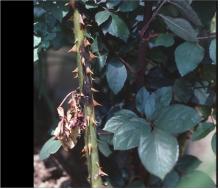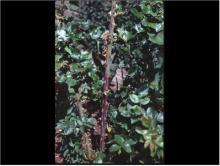Cause An undetermined pathovar of Pseudomonas syringae, a bacterium. This disease is different from the various symptoms on roses previously attributed to P. syringae and/or P. syringae pv. morsprunorum in the literature. An aggressive cane blight has been observed in the Treasure Valley of Idaho since 1996. Symptoms were common under cool, wet conditions in spring (March to May) and the level of incidence and severity of the disease varied from year to year. Several cultivars of climbing, floribunda, grandiflora, hybrid tea, hybrid perpetual, miniature and shrub roses can show severe symptoms.
Symptoms The symptoms usually started at the base of a vegetative bud or at leaf scars or wounds, as reddish-brown areas on the bark that later turn dark-purple-to-black and necrotic. The necrotic areas expanded around and along the cane, often involving a major part or even the entire cane. Vegetative buds on the affected parts of the cane turned brown and dried. The surface of the necrotic areas of the bark was glossy, and the tissue beneath the epidermis was brown to dark brown, and moist in the early stages. Often confused with winter injury.
Cultural control The following is suggested in the absence of specific research to control this problem.
- Remove and destroy infected stems.
- Disinfect pruning shears before cutting more stems.
Chemical control Spray before fall rains begin and again when half the leaves have fallen. Repeat in spring to protect new growth.
Products available in home packaging:
- Bonide Copper Fungicide at 8 oz/3 gal water. Group M1 fungicide. H
- Monterey Liqui-Cop at 3 Tbsp/gal water. May discolor blooms. Group M1 fungicide. H
Products available for commercial use:
- Badge X2 at 1.5 to 2 lb/A. Group M1 fungicide. 24-hr greenhouse reentry. O
- C-O-C-S WDG at 2 to 3.9 lb/100 gal water. Group M1 fungicide. 48-hr reentry general or 24-hr reentry for greenhouse.
- CuPRO 5000 at 1.5 to 5 lb/A but only up to 2 lb/A when new growth is present. May discolor foliage or blooms. Group M1 fungicide. 48-hr reentry.
- Junction at 1.5 to 3.5 lb/A. Some cultivars have shown discoloration of foliage and/or blooms. Group M1 + M3 fungicide. 48-hr reentry.
- Phyton 27 at 1.5 to 3.5 oz/10 gal water. Group M1 fungicide. 48-hr reentry.
Reference Mohan, S.K. and Bijman, V.P. 2010. Bacterial cane blight of rose caused by Pseudomonas syringae. Acta Hort. 870:109-113.




